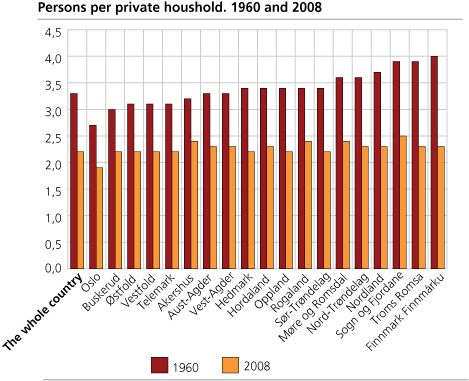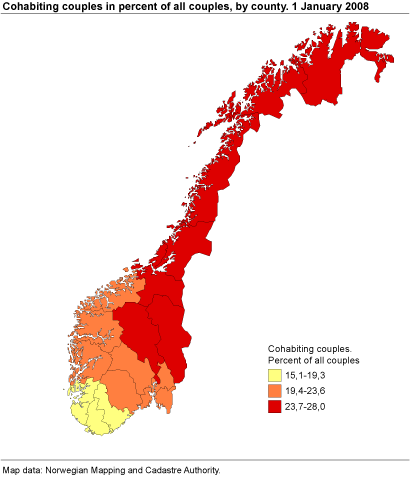Content
Published:
This is an archived release.
More people live alone
The number of private households was 2.1 million on 1 January 2008. During the past 50 years, the number of private households has almost doubled, while the population has increased by about a third. This means that during this period there has been a considerable decrease in household size.
More people live alone than ever before. Almost 40 per cent of all private households consist of one person, compared with 14 per cent in 1960. The average number of persons per household has decreased from 3.3 in 1960 to 2.2 at the turn of this year.
Most people live alone in Oslo
163 500 people now live alone in Oslo. This means that 55 per cent of all private households consist of one person. In Oslo, the percentage varies considerably from area to area. In St. Hanshaugen and Sagene more than 70 per cent of all households consist of one person. On the other hand, one-person households only accounts for 30 to 40 per cent of all private households in Stovner and Sagene
Oslo continues to have the smallest households with an average of 1.9 people per household, while Sogn og Fjordane still has the largest households with 2.5 people per household.
Sogn og Fjordane, Rogaland, Akershus and Møre og Romsdal have the largest households. In 1960, the three northernmost counties and Sogn og Fjordane topped the ranking. At that time, Akershus was among the counties with fewest people per household. The largest households are mainly found in Southern and Western Norway, and also in municipalities in the commuting areas around the larger cities. The number of small households is highest in central urban municipalities and in remote areas.
Many elderly live alone
On 1 January 2008, 827 900 people lived alone in Norway, accounting for 17.6 per cent of all residents in private households. The proportion of persons living alone is highest among elderly people. Among persons 80 years and over, nearly 6 out of 10 persons live alone, while 1 out of 3 in the age group 67-79 years lives alone. Oppland and Oslo have the highest proportion of elderly living alone, while the proportion is lowest in Akershus and Sogn og Fjordane.
Most cohabiting couples in Oslo and the northernmost counties
Oslo, Hedmark and Oppland, as well as the counties in Trøndelag and Northern Norway have the highest proportion of cohabiting couples. Sør-Trøndelag and Finnmark topped the ranking with 28 per cent, while Aust-Agder, Vest-Agder and Rogaland were at the bottom. Marriage is most common in the coastal counties from Vestfold to Møre og Romsdal, and in Østfold.
Less than 6 per cent of households consist of single mothers or fathers with children in the age group 0-17 years (nine out of ten are mothers). Finnmark was top in this category with about 7 per cent, while Sogn og Fjordane was at the bottom with under 5 per cent.
|
The statistics are based on registers and legal residence address on 1 January 2008. This means that unmarried students registered at their parents' address are regarded as members of the household of their parents. Experience shows that statistics based on registers and legal residence address result in larger households, fewer one-person households and fewer cohabiting couples than statistics from surveys based on interviews and place of usual residence. |
Tables:
- Table 1 Population by, sex, age and type of household. 1 January 2008
- Table 2 Private households and persons per private household, by county. 1960, 1970, 1980, 1990, 2001, 2005, 2006, 2007 and 2008
- Table 3 Private households, by type of household. 1980, 1990, 2001, 2005, 2006, 2007 and 2008. Number and per cent
- Table 4 Private households and persons in private households, by size of household, county, municipality and urban district. 1. January 2008 (Corrected 7 May 2008)
- Table 5 Private households, by type of household, county, municipality and urban district. 1 January 2008 (Corrected 7 May 2008)
- Table 6 Private households, by type of household, county, municipality and urban district. 1 January 2008. Per cent (Corrected 7 May 2008)
- Table 7 Private households and persons in private households, by type of household. 1 January 2008. Numbers and per cent
- Table 8 Persons in private households, by type of household, county, municipality and urban district. 1 January 2008. Per cent (Corrected 7 May 2008)
- Table 9 Families in private households, by type of family, county, municipality and urban district. 1 January 2008 (Corrected 7 May 2008)
- Table 10 Families in private households with children 0-17 years by, county, type of family and number of children. 1 January 2008
- Table 11 Persons in private households, by sex, cohabitation arrangements and age. 1 January 2008
- Table 12 Couples and persons in couples with and without children in private households, by cohabitation arrangements, number of children in the family and age. 1 January 2008
- Table 13 Couples with and without children in private households, by cohabitation arrangements, county, municipality and urban district. 1 January 2008. Per cent
- Table 14 Persons 18 years and over in private households. Percentage living/not living as couples, by age, county, municipality and urban district.l. 1 January 2008. Per cent (Corrected 28 April 2008)
- Table 15 Persons 67 years and over in private house holds, by age and number of persons living in the household. County, municipality and urban district. 1 January 2008 (Corrected 7 May 2008)
Contact
-
Statistics Norway's Information Centre
E-mail: informasjon@ssb.no
tel.: (+47) 21 09 46 42
-
Espen Andersen
E-mail: espen.andersen@ssb.no
tel.: (+47) 92 61 00 46
-
Ane Margrete Tømmerås
E-mail: ane.tommeras@ssb.no
tel.: (+47) 91 99 29 62
-
Oppdrag befolkningsstatistikk
E-mail: befolkning@ssb.no


